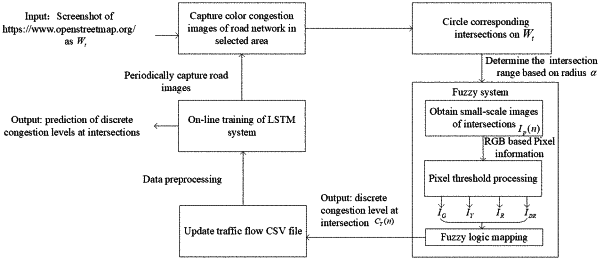| CPC G08G 1/0133 (2013.01) [G06T 7/20 (2013.01); G06T 7/90 (2017.01); G06T 2207/10024 (2013.01); G06T 2207/20081 (2013.01); G06T 2207/20084 (2013.01); G06T 2207/30236 (2013.01)] | 5 Claims |

|
1. A large-scale real-time traffic flow prediction method based on fuzzy logic and deep LSTM (long short-term memory) neural network, comprising steps of:
1) selecting an urban road network scene to collect color images of real-time traffic flow congestion information;
2) obtaining congestion levels of multiple intersections used in a data training set according to the color images; and forming a data sensing end of an FDFP (Fuzzy logic and Deep learning based Flow Prediction) model through a fuzzy mechanism;
3) establishing a deep LSTM neural network, performing deep learning on the data training set, and constructing a prediction end of the FDFP model;
4) inputting real-time traffic information obtained from a server into the FDFP model to real-time obtain traffic prediction for the multiple intersections within a certain future time range, and evaluating actual real-time traffic conditions of each of the intersections on prediction effects of different models;
5) inputting periodically updated predictions from the LSTM neural network to obtain congestion based graph G(N,E) of the urban road network, wherein N represents the set of intersections {ni, ni, . . . } and E represents set of edges;
6) obtaining all Euclidean distances for the graph G(N, E), and then normalizing the Euclidean distances in range (0,1], so that |dij| is a normalized distance between an intersection ni and nj for an edge eij;
7) obtaining estimated congestion of k-nearest neighbors Ki of every intersection ni in the graph G(N, E) as:
 and
8) obtaining estimated congestion of every edge eij in the graph as:
 wherein ŷt(eij) is the estimated congestion at the edge eij, ŷt(nij) represents the average congestion of ni and nj, and ŷt(Kij) represents average congestion of the k-nearest neighbors of ni and nj.
|